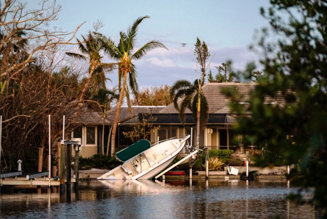|
Hurricane Ian exposed
a flood insurance nightmare for homeowners in Florida
Residents on Sanibel Island,
a small coastal community outside Fort Myers, suffered a direct
hit. A lack of insurance could prove life-altering for them and
many other Floridians. |
Article Courtesy of NBC NEWS
By Phil McCausland
Published
October 17, 2022
Hurricane Ian’s storm surge brought numerous feet of
water into homes on Florida's west coast, and left behind mold, muck,
mud and a flood insurance nightmare for residents who want to rebuild.
|
Many Floridians who suffered extensive
flooding did not carry a separate flood insurance policy to
cover the damage caused by the deadly storm. It’s left
homeowners — and even renters — with a hefty and, possibly,
life-changing expense that could decide whether they are
rendered homeless.
Susan Cavanaugh and her two kids are living through that
ordeal after the first floor of their home on Sanibel
Island, where all three live and work, was engulfed by the
storm surge. Cavanaugh did not have flood insurance
coverage.
Now she doesn't know how to get her family back into their
home without an insurance check to pay for contractors and
building materials.
“I can only do so much as a single mom,” said Cavanaugh, who
is staying in a motel and is unsure where to live next. “We
just want to go back to the house. It’s been deemed
structurally sound, but we have to get it back online and
it’s not just a cosmetic issue. It’s going to take blood,
sweat and tears and it’s going to take a lot of muscle and a
lot of work to get there.”
|
|
A displaced boat in the wake of Hurricane Ian on
Sanibel Island, Fla., on Oct. 1.
|
Sanibel Island last month suffered a direct hit from
the Category 4 storm and the surge of water, up to 15 feet in some
places, it brought from the gulf into people’s homes. The community
remains inaccessible by car, forcing many to pay boat captains to ferry
them to begin the cleanup.
Cavanaugh is not alone in facing flood damage without the backing of
insurance coverage. Many people in the small coastal community, which
faces the Gulf of Mexico southwest of Fort Myers, did not have flood
insurance coverage.
What's more, Sanibel Island is a microcosm of a greater insurance
challenge facing Florida and the country.
nly about 18.5% of homes in Florida counties that faced a mandatory or
voluntary evacuation order the evening before Hurricane Ian landed had a
flood insurance policy with the National Flood Insurance Program, the
federal government program administered by FEMA, according to an
analysis conducted by the risk management consulting firm Milliman. Even
in designated flood hazard zones within those counties, fewer than half
of the homes had a policy on file.
It appears that, despite an increased occurrence of devastating flood
events, a declining percentage of people nationwide have flood insurance
policies. The number of policies maintained by the National Flood
Insurance Program has declined by nearly 700,000 since 2008, according
to data acquired from the federal agency.
“There are many factors that influence this drop in policyholders,
including the economic impact of the pandemic, the housing market,
affordability, or purchasing flood insurance from the private market,”
David Maurstad, the senior executive of the National Flood Insurance
Program, said in a statement.
He said that FEMA “continues to market the flood insurance product
throughout the country” in an effort “to increase the number of
properties covered by flood insurance.” Currently about 5 million
policies are under the National Flood Insurance Program, which was
created in the 1960s because the private insurance market increasingly
declined to cover flood events.
It’s an expensive undertaking for the federal government. Since 2008,
the program has paid out $40.1 billion to slightly more than 910,000
claims, according to FEMA’s data, and the agency still owes about $20
billion to the U.S. Treasury after borrowing funds to pay out many of
those claims.
With climate change leading to more dangerous storms and expanding the
risk of flooding, the U.S. and its coastal communities are beginning to
suffer the pitfalls of building in flood-prone areas.
“The risk is there as weather losses are on the rise,” said Lynne
McChristian, the director of the Office of Risk Management & Insurance
Research at the University of Illinois, “and those exposures are growing
because we’re building more expensive things in the most vulnerable
areas.”
|
